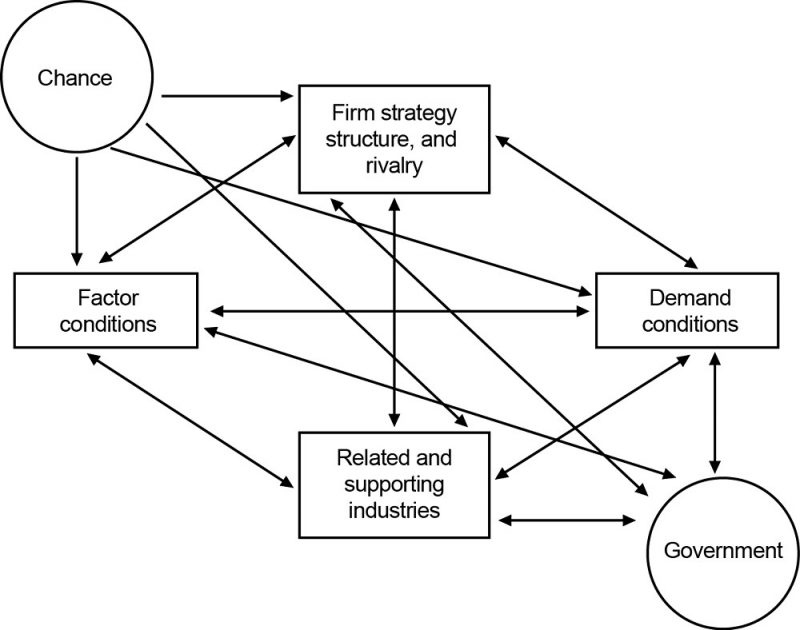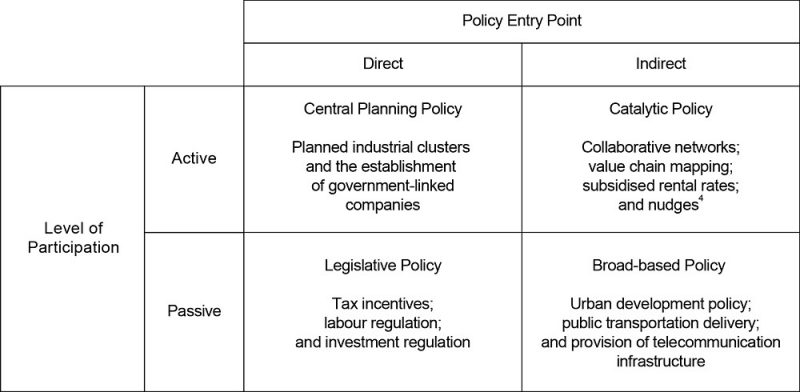Executive Summary
- The Batu Kawan Industrial Park has the makings of a successful cluster. The Penang state government has identified relevant policies to secure its position as the “Silicon Valley of the East”, as evidenced by the Eco City Batu Kawan and the Penang Digital Transformation Masterplan
- The success of the industrial park, however, hinges on the proper implementation and realisation of these plans
- Although industrial parks are developed to reap the benefits of competitive advantage such efforts often fall short due to two misconceptions. These are: Reverse engineering and Industrial targeting
- Replicating elements of a successful cluster does not guarantee another successful cluster, while clustering is not a tool that supports arbitrary industry handpicking
Introduction
A recent study by the Institute for Democracy and Economic Affairs (IDEAS) found that Cyberjaya has fallen short in realising its vision to become a “Malaysian Silicon Valley” (Salman, 2018). Central to this study are two opposing ideas about the government’s role in the development of industrial clusters; most notably, should clusters be created from scratch or should existing ones be nurtured?
This debate could not have been timelier, particularly for Penang’s branding as the “Silicon Valley of the East” (BBC 2018; Chia, 2017). The state is on the cusp of developing the new Batu Kawan Industrial Park (BKIP), arguably from scratch. Combined, these two developments seem to share similar makings of an infancy-stage Cyberjaya. This brief explores the government’s role in the development of an industrial cluster, and what this may mean for the BKIP.
Clustering and Economic Agglomeration
Economists have long observed that firms are likely to form clusters in specific locations; this is largely explained by the economic benefits of being in close proximity, or what economists term “agglomeration economies”. These are categorised into localisation economies, which develop from the clustering of firms from similar industries, and urbanisation economies, which occur from the congregation of diverse firms in close spatial proximity (McCombie and Spreafico, 2014). The take-home message is this: It is better for firms to be in a group than alone. [1]
None popularised this into a policy better than Michael Porter of Harvard Business School. He (2000) defines clusters as: “…geographic concentrations of interconnected companies, specialist suppliers and service providers, firms in related industries and associations (e.g. universities, standards agencies and trade associations) in particular fields that compete but also cooperate.”
In his analysis, Porter posits that clustering results in innovative economies that are highly efficient and able to create high value-added products and services. The use of a competitive advantage framework by design allows for the inclusion of competitive and productive behaviour by firms. Through this, Porter proposes that competitive clusters are not merely defined by the co-location of firms, but more importantly, through interrelationships and collaboration.
Such interrelationships and collaboration are presented in Porter’s diamond model (Figure 1), which depicts four fundamental interdependent determinants of competitive advantage: factor conditions; demand conditions; related and supporting industries; and firm strategy, structure and rivalry. [2] By extension, Porter argues that these “diamond determinants of competitive advantage” can be accelerated through clusters.
Figure 1: Porter’s Diamond Model of Competitive Advantage

Misconceptions that Lead to Failure
Many countries subscribe to the cluster theory. Usually nestled within some form of industrial policy, clustering is expected to play a catalytic role on economic progress. This is hardly surprising considering the theory promises to elevate firms into innovative and high value-added industries on par with the Silicon Valley and other successful high-tech parks in Asia. More importantly, it lays down a guiding checklist – an enticing prospect given how seemingly straightforward and feasible the cluster theory is in meeting its goals. In practice however, this is not always the case: Cyberjaya and Malaysia’s failed USD150mil BioValley complex, also known as the “Valley of the BioGhost”, are prime examples. But why this conundrum?
A determining factor is the practice of “reverse engineering”, stemming from policymakers’ misconception of the causal relationship within the cluster theory. Put simply, while all successful clusters exhibit elements of the “diamond determinants of competitive advantage”, the exhibition of all such elements do not guarantee a successful cluster. Indeed, Woodward and Guimaraes (2009) note that the diamond model emerged inductively through case studies of successful clusters, rather than through deductive logic or rigorous empirical analysis. Additionally, it has been shown that not all factors contribute equally to the success of a cluster. Rojas (2007) for example, posits that demand conditions enable other determinants, while Ketels (2003) argues for a system-effect in reference to how the weakest element sometimes has the strongest impact on the success of a cluster, while implicitly acknowledging that each element is in fact essential. It does seem that the guiding checklist offered by the cluster theory masks a great amount of complexity.
Another source of contention lies in the misconception between cluster theory and industrial targeting. At its core, cluster theory is about how a region can make what it produces better, and not what a region should produce. It is the latter, that industrial targeting seeks to address. However, industrial targeting has its own due considerations – a big portion of this is in the contention of what selection criteria are to be used to target a specific industry. These are often vague and misconceived at best, and at worst, erroneous and baseless altogether (Krugman, 1983). The Economist for example, has this to say about Malaysia’s failed attempt at industrial targeting:
“Although Malaysia had few skilled biologists, its politicians decided to build
BioValley on the ruins of Entertainment Village, an attempt to create a Malaysian
Hollywood that failed for lack of media nous” (The Economist, 2009).
Researchers have rightfully found successful clusters to be path dependent. While this implies many things, the notion that a region can approach industrial policy from an arbitrary pick-and-choose position is not one of them. [3] Using clustering to realise that dream will only result in failure. Erroneous industrial targeting may very well have had failure built into its design.
Untangling the Role of Governments
With the range of policy tools available to them, governments are pivotal in ensuring the successful formation of industrial clusters. The Cluster Policy Nexus is introduced below to identify these considerations. It determines policy tools according to two fundamental characteristics that dictate their risks and conditions for success:
- Level of participation
- Active policy is highly interventionist, and therefore requires active monitoring throughout the implementation process. Such a policy is usually prolonged and demands high levels of political and financial capital
- Passive policy is characterised by its nature of being institutionalised. The processes required for executing such a policy are easily embedded into the government machinery; as such, they appear to be automated and do not require continuous reviewing
- Policy entry point
- Direct policy gains impact on outcomes or on stakeholders through precise targeting. This requires an extensive amount of information gathering and in-depth knowledge regarding the area of intervention
- Indirect policy is a subtler approach which displays blanket properties with broad spill over effects, signifying more than proportionate returns to investment
This allows for combinations of four policy categories (Figure 2):
Figure 2: Cluster Policy Nexus

The Batu Kawan Industrial Park
The BKIP is a project jointly developed by the Penang Development Corporation, the Penang state government and the Seberang Perai Municipal Council. [5] It is a prime example of an industrial cluster as advanced by Porter, and makes for an instructive case study for the following reasons:
1. BKIP is not a centrally-led cluster
Unlike other central-led industrial clusters, BKIP is the result of an organic growth from existing clusters in the Bayan Lepas area. This implies that since its inception, BKIP has already amassed sufficient demand for agglomeration economy effects. The presence of a few large, prolific companies since its launch is evidence of this.
2. BKIP is path dependent in high-tech products
Reflecting its organic growth, BKIP is already earmarked to be path dependent in high-tech products. More specifically, it mirrors Penang’s strength in the semiconductor industry and its associated sectors – for example, the industrial park is already home to Vitrox’s Centre of Excellence for Machine Vision and the Penang Automation Cluster. This bolsters potential for groundbreaking and forefront research that would serve as a driving force for an innovative and productive industrial cluster. If anything, BKIP has a realistic potential of becoming the “Silicon Valley of the East”.
3. BKIP is still largely undeveloped
BKIP holds incredible potential to incorporate modern, progressive and futuristic ideas into its initial design, an opportunity that established real estates will never have. In the area of spatial design for example, BKIP allows for the re-imagining of infrastructure that are people-centric, and not vehicle-centric. It also allows for the roll-out of new technologies in areas like environmental conservation, urban security, public well-being and sustainable living. These have come to define modern “smart cities”; a coveted position given the difficulties in incorporating new technologies in older and more established cities.
4. BKIP is in possession of necessary political capital
The state government has great plans for BKIP. Under the banner of Eco City Batu Kawan, the government envisions to “create a sustainable city growth with higher social, economic and environmental quality of life for its residents” (Phee, 2018). The BKIP is also being steered into realising the state’s aspirations of becoming digitally transformative by being involved in the production and consumption of nascent technologies. This is taken into account in the drafting of the Penang Digital Transformation Masterplan. At the same time, Penang and Malaysia in general have just experienced a “changing of the guard”, further accumulating political capital to implement transformative ideas and ensuring BKIP’s future as a successful industrial cluster.
BKIP and the Penang Digital Transformation Masterplan
The Penang state government drafted the Penang Digital Transformation Masterplan (PDTMP) to unlock the state’s digital potential. It envisions a Penang characterised by a supportive environment for the pervasive use and development of digital technologies that would lead to high productivity jobs, new value-added industries and a high-quality lifestyle. The BKIP is to play an integral part in achieving this vision and therefore, have elements of it entwined into the plan. These include:
1. Value chain mapping
Value chain mapping is an exercise that seeks to provide a holistic and in-depth snapshot of the industries positioned along the value chain. This is an example of a catalytic policy that would help identify areas where new networks and collaborations need to be formed to move industries up the value chain. Such an exercise will allow for the identification of negative disruptions that should be pre-empted, and positive disruptions that should be leveraged on.
2. The development of Batu Kawan Innovation District
Batu Kawan Innovation District is envisioned to be a site offering mixed-use housing, office and retail where leading-edge anchor institutions and industry clusters can connect with startups, business incubators and accelerators. The innovation district will grow new industrial clusters and showcase the adoption of new technologies that is possible in the digital economy. Encompassing BKIP and its surrounding areas, Batu Kawan Innovation District will serve as a comprehensive test bed for nascent technologies aimed at raising quality of life, and to stretch what “live, play and work” would mean with the incorporation of digital technologies. This is an example of a central planning policy.
3. Designing innovative public spaces
Innovative public spaces are predicted to play a catalytic role in innovation by bringing together people who would otherwise not meet. In agglomeration economic effects, this is colloquially known as the industry “rumour pot”. Acting very much as a behavioural nudge, innovative spaces are designed to encourage collaborations, new ideas, and expressions, reflective of the open and collaborative nature of innovation. This is an example of a broad-based policy.
Take-Homes
Essentially, BKIP shows promise of becoming a successful cluster. Assuming this continues, the cluster theory posits that the industrial park will be able to “make what it produces better”. Coupled with its already established path dependence in high-tech industries, it is not too far-fetched then to conclude that Penang is poised to become the “Silicon Valley of the East”. But this hangs on the caveat that the government identifies and implements the right policies. In this respect, the Eco City Batu Kawan and the PDTMP are examples that fulfil this criterion. It is up to the government to bring these together; not as a central planner, but as one to nurture the growth of BKIP.
Bibliography
BBC. (2018, January 22). BBC. (P. Parker, Producer) Retrieved August 2018, from The Malaysian region that became a hardware hub: https://www.bbc.com/news/av/business-42686192/the-malaysian-region-that-became-a-har dware-hub
Chia, L. (2017, January 26). Channel News Asia. Retrieved August 2018, from A Silicon Valley of the East: Penang’s thriving start-up community: https://www.channelnewsasia.com/news/asia/a-silicon-valley-of-the-east-penang-s-thriving- start-up-communit-7576346
Halpern, D. (2015). Inside the Nudge Unit; How Small Changes can Make a Big Difference. WH Allen.
Krugman, P. R. (1983). “Targeted Industrial Policies: Theory and Evidence,” in Industrial Change and Public Policy. Federal Reserve Bank of Kansas City.
Lin, G., & Sun, C.-C. (2010). Driving Industrial Clusters to be Nationally Competitive. Technology Analysis & Strategic Management, 22(1), 81-97.
McCombie, J., & Spreafico, M. (2014). Economic Geography and Cluster Policy, With Special Reference to Khazakhstan. Cambridge Centre for Economic and Public Policy.
Phee, B. (2018). Planning of Eco-City & green Technologies in Province Wellesley, Penang, Malaysia. 14th Asia Pacific Eco-Business Forum. Kawasaki City: Environmental Technology Knowledge.
Porter, M. (1990). The Competitive Advantage of Nations. New York: Free Press.
Porter, M. (2000). Locations, Clusters and Company Strategy. In G. Clark, M. Feldman, & M. Gertler, The Oxford Handbook of Economic Geography. Oxford: Oxford University Press.
Rojas, T. (2007). Natural Forest Economic Clusters: A New Model for Assessing National-Forest-Based Natural Resources Products and Services. United States Department of Agriculture.
Salman, A. (2018, July). Create or Nurture? Lessons from Cyberjaya: Malaysia’s Promised Silicon Valley. Policy Ideas(50).
The Economist. (2009, October 29). The Economist. Retrieved August 2018, from Fish out of water: https://www.economist.com/business/2009/10/29/fish-out-of-water
Woodward, D., & Guimaraes, P. (2009). Porter’s Cluster Strategy and Industrial Targeting. In S. Goetz, S. Deller, & T. Harris, Targeting Regional Economic Development. London: Routledge
[1] The author highly recommends reading McCombie and Spreafico (2014) for a more thorough discussion on the subject matter.
[2] The elaboration of the model is beyond the scope of this paper. Readers are encouraged to refer to Rojas (2007) for a concise summary of the diamond model.
[3] This however happens more often than not, given the lure of high-tech industry sectors, and the pressure for governments to place buzzwords on their policy agenda.
[4] Nudge, a policy tool that is gaining prominence among governments around the world, is a “means of encouraging or guiding behaviour without mandating or instructing, and ideally without the need for heavy financial incentives or sanctions” (Halpern, 2015). Nudge brings the application of psychology into mainstream policymaking with the promise that small changes can make a big difference.
[5] See http://www.pdc.gov.my/images/pdcwork/core_areas/Industry/BKIP.pdf for a map of BKIP.
Managing Editor: Ooi Kee Beng, Editorial Team: Regina Hoo, Lim Su Lin, Nur Fitriah, Ong Wooi Leng
You might also like:
![Malaysia’s Northern States: Improving Competitive Advantages and Industrial Growth]()
Malaysia’s Northern States: Improving Competitive Advantages and Industrial Growth
![Evaluating the Penang South Reclamation (PSR) Project According to the United Nations’ Sustainable D...]()
Evaluating the Penang South Reclamation (PSR) Project According to the United Nations’ Sustainable D...
![Deconstructing Trump’s Tariffs: The Impact on Penang’s Trade and Economic Resilience]()
Deconstructing Trump’s Tariffs: The Impact on Penang’s Trade and Economic Resilience
![Stuck in Traffic: Why Malaysia Does Not Have a Motorcycle Ride-hailing Sector]()
Stuck in Traffic: Why Malaysia Does Not Have a Motorcycle Ride-hailing Sector
![Mandatory Public Whipping May Become a National Trend]()
Mandatory Public Whipping May Become a National Trend







